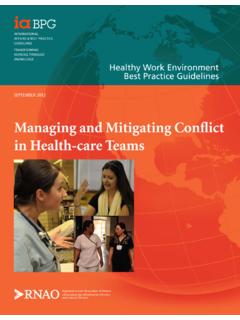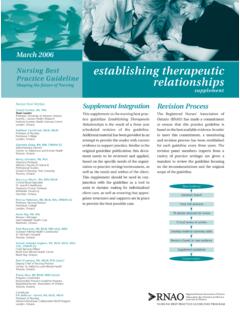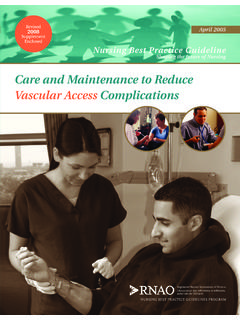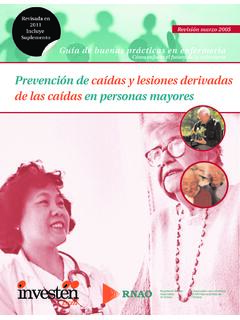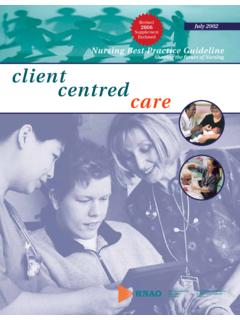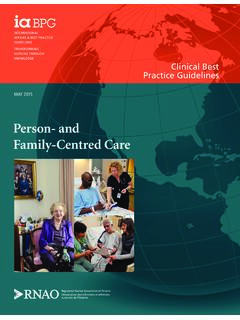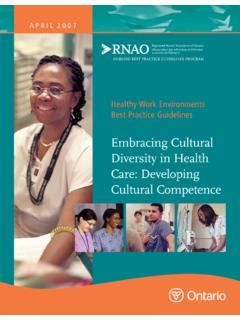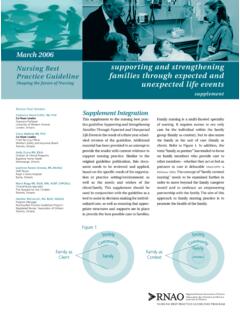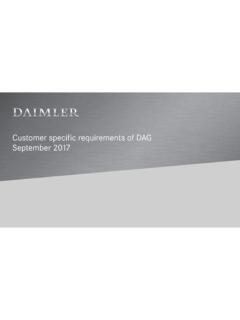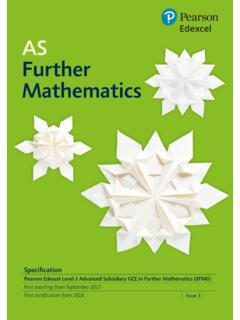Transcription of SEPTEMBER 2017 Preventing Falls and Reducing Injury …
1 Clinical Best Practice Guidelines SEPTEMBER 2017 . Preventing Falls and Reducing Injury from Falls Fourth Edition Disclaimer These guidelines are not binding on nurses, other health-care providers, or the organizations that employ them. The use of these guidelines should be flexible, and based on individual needs and local circumstances. They constitute neither a liability nor discharge from liability. While every effort has been made to ensure the accuracy of the contents at the time of publication, neither the authors nor the Registered Nurses' Association of Ontario (RNAO) gives any guarantee as to the accuracy of the information contained in them or accepts any liability with respect to loss, damage, Injury , or expense arising from any such errors or omission in the contents of this work. Copyright With the exception of those portions of this document for which a specific prohibition or limitation against copying appears, the balance of this document may be produced, reproduced, and published in its entirety, without modification, in any form, including in electronic form, for educational or non-commercial purposes.
2 Should any adaptation of the material be required for any reason, written permission must be obtained from RNAO. Appropriate credit or citation must appear on all copied materials as follows: Registered Nurses' Association of Ontario. ( 2017 ). Preventing Falls and Reducing Injury from Falls (4th ed.). Toronto, ON: Author. Funding This work is funded by the Ontario Ministry of Health and Long-Term Care. All work produced by RNAO is editorially independent from its funding source. Contact Information Registered Nurses' Association of Ontario 158 Pearl Street, Toronto, Ontario M5H 1L3. Website: Preventing Falls and Reducing Injury from Falls Fourth Edition Preventing Falls and Reducing Injury from Falls Fourth Edition Greetings from Doris Grinspun, Chief Executive Officer, Registered Nurses' Association of Ontario The Registered Nurses' Association of Ontario (RNAO) is delighted to present the fourth edition of the clinical Best Practice Guideline Preventing Falls and Reducing Injury from Falls .
3 Evidence-based practice supports the excellence in service that health professionals are committed to delivering every day. We offer our heartfelt thanks to the many stakeholders who are making our vision for best practice guidelines a reality, starting with the Government of Ontario, for recognizing RNAO's ability to lead the program and for providing multi-year funding. For their invaluable expertise and stewardship of this Guideline, I wish to thank the co-chairs of the expert panel, Sandra Ireland and Robert Lam. I also want to thank Dr. Valerie Grdisa, Director of the RNAO International Affairs and Best Practice Guidelines Centre, for her expertise and leadership. Thanks also to RNAO staff Susan McNeill (Guideline Development Lead), Verity White (Guideline Development Project Coordinator), Laura Legere (Lead Nursing Research Associate), and the rest of the RNAO Best Practice Guideline Program Team, for their intense work in the production of this Guideline.
4 Special thanks to the members of the expert panel for generously providing their time and expertise to deliver a rigorous and robust clinical resource. We couldn't have done it without you! Successful uptake of best practice guidelines requires a concerted effort from educators, clinicians, employers, policy-makers, and researchers. The nursing and health-care community, with their unwavering commitment and passion for excellence in patient care, have provided the expertise and countless hours of volunteer work essential to the development and revision of each Best Practice Guideline. Employers have responded enthusiastically by nominating best practice champions, implementing guidelines, and evaluating their impact on patients and organizations. Governments at home and abroad have joined in this journey. Together, we are building a culture of evidence-based practice.
5 We invite you to share this Guideline with your colleagues from other professions and with the patient advisors who are partnering within organizations, because we have so much to learn from one another. Together, we must ensure that the public receives the best possible care every time they come into contact with us making them the real winners in this important effort. Doris Grinspun, RN, MSN, PhD, LLD (Hon), O. ONT. Chief Executive Officer Registered Nurses' Association of Ontario 2 R E G I S T E R E D N U R S E S ' A S S O C I AT I O N O F O N TA R I O. Preventing Falls and Reducing Injury from Falls Fourth Edition Table of Contents How to Use This Document .. 5. Purpose and Scope.. 6. Interpretation of Evidence.. 9. BACKGROUND. Quality of Evidence .. 10. Summary of Recommendations.. 11. RNAO Best Practice Guideline Program Team .. 15. RNAO Expert Panel .. 16. Stakeholder Acknowledgment.
6 18. Background Context .. 22. Practice Recommendations.. 25. Education Recommendations.. 45. R E C O M M E N D AT I O N S. Organization and Policy Recommendations.. 48. Research Gaps and Future Implications.. 53. Implementation Strategies.. 55. Guideline Evaluation.. 57. Process for Update and Review of Best Practice Guidelines.. 60. Reference List .. 61. REFERENCES. BEST PRACTICE GUIDELINES w w w. R N A O . c a 3. Preventing Falls and Reducing Injury from Falls Fourth Edition Appendix A: Glossary of Terms.. 73. Appendix B: Concepts That Align with This Guideline .. 81. Appendix C: Guideline Development Process.. 83. Appendix D: Systematic Review and Search Strategy.. 84. Appendix E: List of Risk Factors.. 88. APPENDICES. Appendix F: Summary of Findings Approaches and Tools for Assessing Falls Risk.. 92. Appendix G: Interventions for Falls Prevention and Injury Reduction.
7 98. Appendix H: Exercise and Physical Training Interventions .. 104. Appendix I: Medication Resources.. 108. Appendix J: Post- fall Assessment Resources and Example.. 109. Appendix K: Components and Example of Universal Falls Precautions .. 113. Appendix L: Resources.. 116. Endorsements .. 121. ENDORSEMENTS. Notes .. 128. N OT E S. 4 R E G I S T E R E D N U R S E S ' A S S O C I AT I O N O F O N TA R I O. Preventing Falls and Reducing Injury from Falls Fourth Edition How to Use This Document BACKGROUND. This nursing best practice guideline (BPG)G* is a comprehensive document that provides resources for evidence- based nursing practiceG. It is not intended to be a manual or how to guide, but rather a tool to guide best practices and enhance decision-making for nursesG and other health-care providersG working with adults (18 years and older). who are at risk for Falls G and fall injuriesG.
8 The Guideline should be reviewed and applied in accordance with both the needs of individual organizations or practice settings, and the needs and preferences of persons and their familiesG. accessing the health system for care and services. In addition, the Guideline offers an overview of appropriate structures and supports for providing the best possible evidence-based care. Nurses, other health-care providers, and administrators who lead and facilitate practice changes will find this Guideline invaluable for developing policies, procedures, protocols, educational programs and assessments, interventions, and documentation tools, and for supporting adherence to legislation, mandatory programs, and regulations in their practice settings. Nurses and other health-care providers in direct care will benefit from reviewing the recommendations and the evidence that supports them.
9 We particularly recommend that practice settings adapt these guidelines in formats that are user-friendly for daily use. If your organization is adopting this Guideline, we recommend the following approach: 1. Assess your existing Falls prevention/ Injury reduction policies, procedures, protocols, and educational programs in relation to the recommendations in this Guideline. 2. Identify existing needs or gaps in your Falls prevention/ Injury reduction policies, procedures, protocols, and educational programs. 3. Note the recommendations that are applicable to your setting and can be used to address your organization's existing needs or gaps. 4. Develop a plan for implementing the recommendations, sustaining best practices, and evaluating outcomes. 5. Consider bundlingG evidence-based recommendations to achieve greater outcomes. These bundles can be created from a single guideline or from several guidelines to achieve the strategic goals and desired outcomes of the health-care organization.
10 Implementation resources, including the RNAO Toolkit: Implementation of Best Practice Guidelines (2012), are available at For more information, see Implementation Strategies. All of the RNAO BPGs are available for download on the RNAO website at To locate particular BPGs, search by keyword or browse by topic. We are interested in hearing how you have implemented this Guideline. Share your story with us at * Throughout this document, terms that are marked with a superscript G (G) can be found in the Glossary of Terms (Appendix A). BEST PRACTICE GUIDELINES w w w. R N A O . c a 5. Preventing Falls and Reducing Injury from Falls Fourth Edition Purpose and Scope BACKGROUND. Best practice guidelines are systematically developed, evidence-based documents that include recommendations for nurses and the interprofessional teamG, educators, leaders and policy-makers, and persons and their families on specific clinical and healthy work environment topics.
